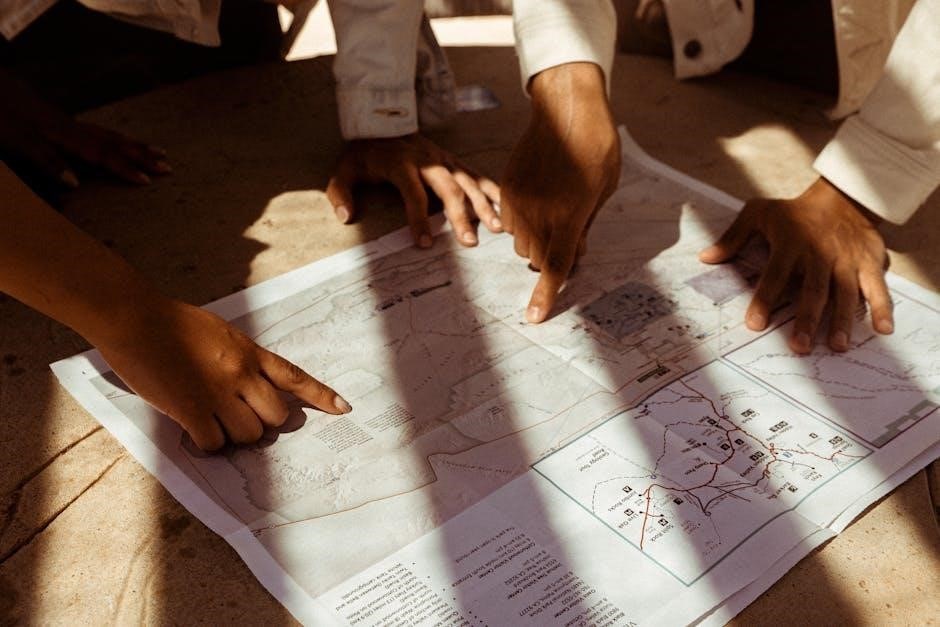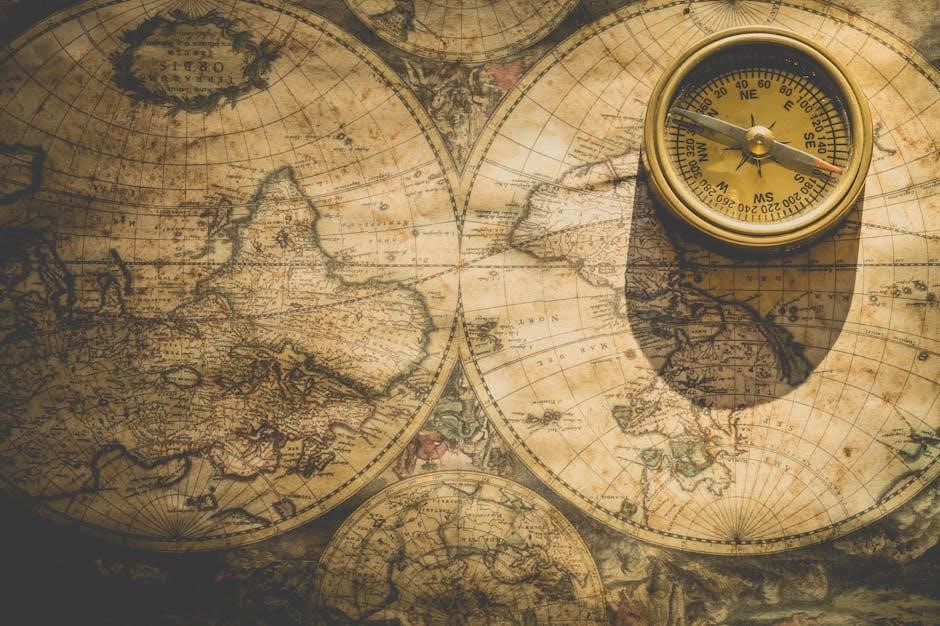
godzilla the ultimate illustrated guide
This essential companion explores Godzilla’s cinematic journey, offering a visually stunning and detailed guide from the classic 1954 film to modern blockbusters, highlighting its cultural impact.
Overview of the Guide’s Purpose and Scope
This illustrated guide is crafted to comprehensively explore Godzilla’s legacy, offering a detailed journey through its cinematic history, cultural significance, and evolving design. It serves as a definitive resource for fans and newcomers alike, showcasing the monster’s impact on global pop culture. The guide spans from Godzilla’s origins in 1954 to modern blockbusters, covering both Japanese and Western adaptations. With rich visuals and insightful commentary, it delves into iconic films, behind-the-scenes techniques, and the creative minds behind the franchise. Designed to be both informative and visually stunning, this guide provides a deep dive into Godzilla’s world, making it an essential companion for anyone fascinated by the King of Monsters.
Historical Context of Godzilla’s Creation
Godzilla’s creation emerged from the cultural and political climate of post-World War II Japan, reflecting fears of nuclear devastation and scientific hubris. The 1954 original film, directed by Ishirō Honda, was inspired by real-world trauma, including the atomic bombings of Hiroshima and Nagasaki. Producer Tomoyuki Tanaka envisioned a monster symbolizing nature’s wrath against humanity’s destructive tendencies. Special effects pioneer Eiji Tsuburaya brought Godzilla to life, blending traditional techniques with innovativeSuitmation. The film’s success resonated deeply with Japanese audiences, tapping into collective anxiety and sparking a global phenomenon. This historical backdrop underscores Godzilla’s enduring relevance as a metaphor for humanity’s relationship with technology and the environment.
The Cultural Significance of Godzilla
Godzilla transcends cinema, embodying cultural and symbolic meanings that resonate globally. As a post-war icon, Godzilla reflects Japan’s trauma and resilience, becoming a national symbol. The monster’s evolution mirrors societal changes, addressing themes like environmentalism and technological ethics. Godzilla’s global popularity bridges cultural gaps, making it a shared pop culture icon. Its influence spans media, art, and literature, cementing its status as a cultural phenomenon. This enduring appeal highlights Godzilla’s ability to adapt and remain relevant, ensuring its continued impact on future generations and solidifying its place in cultural history.

The Evolution of Godzilla’s Design

Godzilla’s design has transformed from practical effects to CGI, evolving its iconic appearance while maintaining its fearsome presence, blending tradition with modern visual storytelling techniques.
Early Concept Art and Design Influences
Godzilla’s original design was inspired by classic monsters like King Kong and real-world fears of nuclear devastation. The 1954 film’s concept art blended a Tyrannosaurus Rex with an alligator, creating a fearsome, towering creature. Historical context played a role, as post-war Japan influenced the monster’s symbolism of destruction and rebirth. Early sketches emphasized Godzilla’s imposing size and texture, with a rough, scaly appearance. The iconic roar and atomic breath were key elements from the start, defining the monster’s identity. Practical effects and suitmation techniques brought Godzilla to life, with actor Haruo Nakajima’s physical performance adding depth. These early designs laid the foundation for Godzilla’s enduring legacy as a cultural icon.
Iconic Costumes and Suitmation Techniques
The original 1954 Godzilla suit, designed by Teizo Toshimitsu and Eiji Tsuburaya, set the standard for the monster’s iconic look. Haruo Nakajima, the stunt actor inside the suit, brought Godzilla to life with his physical performance. The suit’s texture and size emphasized Godzilla’s imposing presence, while the distinctive roar and atomic breath added to its legend. Over the years, suit designs evolved, with materials like rubber and latex used to create more dynamic poses. These practical effects, known as suitmation, allowed for intricate details and expressive movements, making Godzilla a tangible, relatable creature. The costumes and techniques not only defined Godzilla’s appearance but also influenced the visual style of kaiju films, cementing its status as a cinematic icon.
Digital Era Designs and Modern Interpretations
The digital era transformed Godzilla’s design, leveraging CGI and motion capture to create more lifelike and dynamic portrayals. Films like Godzilla (2014) and Godzilla: King of the Monsters (2019) showcased intricate details, such as scaly textures and expressive facial animations. Motion capture allowed actors to infuse Godzilla with nuanced emotions, enhancing its character depth. Modern designs often blend practical and digital elements, ensuring the monster remains awe-inspiring while adapting to contemporary storytelling. These advancements have enabled filmmakers to explore new visual styles, maintaining Godzilla’s iconic presence while appealing to modern audiences. The fusion of tradition and innovation ensures Godzilla’s enduring relevance in global cinema.

Godzilla’s Cinematic History
Godzilla’s cinematic history spans over six decades, evolving from a fearsome symbol of destruction to a beloved cultural icon, showcasing the monster’s enduring appeal and cinematic transformation.
Classic Era: The Original Godzilla Films (1954–1975)
The Classic Era marks the birth of Godzilla, beginning with Ishirō Honda’s 1954 masterpiece, which introduced the iconic monster as a metaphor for nuclear dread. This period saw Godzilla transition from a fearsome destroyer to a heroic figure, reflecting Japan’s evolving post-war identity. Key films like Mothra vs. Godzilla (1964) and Ghidorah, the Three-Headed Monster (1964) showcased the monster’s growing popularity and the introduction of iconic foes. The era’s campy charm, colorful visuals, and memorable soundtracks solidified Godzilla’s cultural status. These films laid the groundwork for future generations, blending science fiction with kaiju spectacle, and remain beloved for their nostalgic value and historical significance in the Godzilla franchise.
Heisei Era: Rebirth and Revival (1984–1995)
The Heisei Era revitalized Godzilla with a fresh narrative continuity, starting with The Return of Godzilla (1984), which rebooted the series by ignoring all previous sequels except the 1954 original. This era emphasized complex storylines and interconnected plots, often exploring themes of nuclear fallout and humanity’s struggle with nature. Films like Godzilla vs. Biollante (1989) introduced new organisms and advanced special effects, while Godzilla vs. King Ghidorah (1991) delved into time travel and alternate histories. This period also saw the rise of iconic foes like Mechagodzilla and Mothra, blending action with deeper philosophical questions. The Heisei Era set a new standard for the franchise, balancing nostalgia with innovation, and remains a fan favorite for its ambitious storytelling and visual grandeur.
Millennium Era: Diversification and Experimentation (1999–2004)
The Millennium Era marked a bold departure for Godzilla, with each film serving as a standalone story, often disregarding previous continuity except for the 1954 original. This period introduced diverse narratives, such as time travel in Godzilla vs. King Ghidorah (1991) and alien encounters in Godzilla 2000 (1999). The era also showcased iconic foes like Orga and Megaguirus, blending traditional monster battles with fresh, sci-fi elements. Visual effects evolved significantly, incorporating CGI alongside classic suitmation, creating a dynamic visual experience. This era’s experimentation allowed Godzilla to adapt to modern audiences while maintaining its core appeal, ensuring the King of Monsters remained relevant in the new millennium.
Reiwa Era: A New Chapter for Godzilla (2016–Present)
The Reiwa Era heralds a new era for Godzilla, blending traditional monster lore with modern cinematic innovation. Films like Shin Godzilla (2016) and Godzilla: Planet of the Monsters (2017) introduced darker, more complex narratives, exploring themes of government response and humanity’s survival. The era also saw global collaborations, such as the Hollywood-produced Godzilla: King of the Monsters (2019) and Godzilla vs. Kong (2021), which brought iconic monsters like King Ghidorah and Kong into the fray. CGI technology reached new heights, offering breathtaking visuals that balanced action and emotional depth. This era emphasizes Godzilla’s role as a global icon, appealing to both long-time fans and new audiences, ensuring the monster’s enduring legacy in contemporary cinema.
Godzilla in Popular Culture
Godzilla’s iconic status extends beyond cinema, influencing music, art, and merchandise. From songs like Blue Öyster Cult’s “Godzilla” to countless references in media and pop art, his global impact endures.
Godzilla’s Impact on Global Pop Culture
Godzilla’s influence transcends cinema, embedding itself deeply into global pop culture. From inspiring countless parodies to featuring in advertisements, Godzilla’s imagery is universally recognizable. The monster’s roar and iconic stance have been referenced in music, memes, and even fashion, solidifying its status as a cultural icon. Collaborations with brands like Nike and Uniqlo highlight Godzilla’s enduring appeal, while songs such as Blue Öyster Cult’s “Godzilla” further cement its legacy in popular media. This cultural ubiquity demonstrates how Godzilla has evolved from a cinematic creature to a symbol of pop culture itself, resonating across generations and continents.
Movies, TV Shows, and Documentaries Featuring Godzilla
Godzilla’s cinematic presence spans over six decades, with appearances in numerous films, TV shows, and documentaries. The original 1954 film launched a franchise, followed by sequels like Godzilla Raids Again and Mothra vs. Godzilla. Hollywood adaptations, such as the 2016 reboot and Godzilla: King of the Monsters, have further expanded its reach. TV series like Godzilla: The Series and documentaries, including The Godzilla Chronicles, delve into the monster’s legacy. These productions showcase Godzilla’s evolution from a fearsome creature to a cultural icon, reflecting its enduring appeal across various media platforms.
Godzilla in Music, Art, and Literature
Godzilla’s influence extends far beyond cinema, leaving an indelible mark on music, art, and literature. The monster has inspired rock bands and album covers, with artists drawing from its iconic imagery. In literature, Godzilla features in novels, comics, and essays, exploring its cultural and symbolic significance. The creature has also been a muse for visual artists, with interpretations ranging from traditional Japanese art to contemporary sculptures and murals. Additionally, Godzilla has been celebrated in poetry and fan-created works, showcasing its universal appeal. This multifaceted presence underscores Godzilla’s role as a cultural phenomenon, transcending its origins as a movie monster to become a global icon of art and creativity.
Merchandise and Collectibles
Godzilla has spawned a vast array of merchandise, from action figures and model kits to apparel and home decor. Collectors eagerly seek rare items like vintage toys, limited edition statues, and exclusive apparel. The creature’s iconic design has been adapted into various forms, including high-end art pieces and everyday items. Additionally, official collaborations with brands have produced unique Godzilla-themed products, further expanding its merchandising reach. These items not only celebrate the monster’s legacy but also cater to diverse fan bases, making Godzilla a staple in pop culture consumerism. As a result, Godzilla merchandise remains a testament to the enduring appeal of the King of Monsters.

Key Monsters and Foes
Godzilla’s universe is populated by iconic monsters like King Ghidorah, Mothra, and Mechagodzilla, each with unique roles in epic battles, shaping the legend of the King of Monsters.
Famous Monsters: King Ghidorah, Mothra, and Mechagodzilla
King Ghidorah, Godzilla’s arch-nemesis, is a towering, dragon-like creature with three heads, embodying destruction and chaos. Mothra, a majestic moth-like deity, often serves as Earth’s protector, contrasting Godzilla’s fury with its serene wisdom. Mechagodzilla, a robotic clone, represents human ingenuity turned monstrous, offering a unique mechanical twist to Godzilla’s battles. These iconic foes have shaped Godzilla’s legend, each bringing distinct challenges and symbolism to the franchise. Their epic showdowns with Godzilla remain unforgettable, highlighting themes of nature, technology, and humanity’s role in the monster’s world. Together, they form the cornerstone of Godzilla’s rich cinematic universe, captivating audiences for decades.
Lesser-Known but Iconic Foes
While Godzilla’s battles with King Ghidorah and Mothra are legendary, other foes like Destoroyah, Biollante, and Gigan leave lasting impressions. Destoroyah, a monstrous embodiment of Oxygen Destroyer’s power, symbolizes ultimate annihilation. Biollante, a genetically engineered hybrid of Godzilla and a rose, represents the dangers of scientific hubris. Gigan, with his buzzsaw arm and cybernetic enhancements, epitomizes alien interference. These creatures, though less prominent, add depth to Godzilla’s universe, each bringing unique challenges and themes. Their designs and stories enrich the franchise, showcasing the versatility of Godzilla’s adversaries and the creativity of kaiju storytelling. They remind fans that Godzilla’s world is vast, filled with intriguing foes beyond the iconic ones.
Monster Battles and Legendary Showdowns
Godzilla’s most epic confrontations are etched in cinematic history, featuring titanic clashes that define the franchise. The iconic battle with King Ghidorah in Shin Godzilla vs. Evangelion showcases strategic brilliance and visual grandeur. Mothra’s sacrificial heroism in Godzilla, Mothra, and King Ghidorah: Giant Monsters All-Out Attack! highlights emotional depth. Mechagodzilla’s mechanical might challenges Godzilla’s dominance, symbolizing humanity’s ingenuity. These battles are not just spectacles but narratives exploring themes of nature, technology, and survival. Each showdown elevates Godzilla’s legacy, proving why he remains the King of the Monsters. The Illustrated Guide captures these moments, offering fans a visual journey through the most unforgettable duels in kaiju history, cementing Godzilla’s place as a cultural icon.

Behind the Scenes
Discover the craftsmanship and dedication behind Godzilla’s creation, from iconic directors shaping the series to the innovative special effects that bring the monster to life.
Special Effects and Suitmation Techniques
Godzilla’s iconic roar and towering presence were brought to life through groundbreaking special effects and suitmation. The original suit, worn by actor Haruo Nakajima, was a rubber costume weighing over 200 pounds, creating the monster’s imposing physique. Miniatures of cities and buildings were meticulously crafted to scale, allowing for realistic destruction scenes. As technology advanced, CGI replaced suitmation, offering greater flexibility and detail. Yet, the legacy of practical effects remains a testament to the ingenuity of early filmmakers. These techniques not only defined Godzilla’s visual identity but also contributed to the monster’s enduring appeal, blending artistry and innovation to create unforgettable cinematic moments.
Notable Directors and Their Contributions
Several visionary directors have shaped Godzilla’s legacy, each bringing unique perspectives. Ishirō Honda directed the 1954 original, blending horror and social commentary. Jun Fukuda infused humor and lightheartedness in the 1970s. Shusuke Kaneko revitalized the franchise in the 1990s with darker themes. Gareth Edwards and Michael Dougherty brought Godzilla to global audiences, merging nostalgia with modern spectacle. Each director’s style has left an indelible mark, ensuring Godzilla remains a cultural icon. Their contributions highlight the monster’s adaptability, evolving with cinematic trends while retaining its timeless essence. This diversity underscores Godzilla’s enduring relevance across generations and continents.
Soundtracks and Music Composition
Godzilla’s iconic soundtracks have played a pivotal role in shaping its cinematic identity. Akira Ifukube’s groundbreaking score for the 1954 original introduced the monster’s haunting roar and ominous marches. His compositions became synonymous with Godzilla’s presence, evoking both fear and awe. Over the years, composers like Masaru Sato and Michiru Oshima have expanded the musical landscape, blending traditional Japanese instruments with orchestral grandeur. The soundtracks not only enhance the emotional depth of the films but also reflect the evolving tone of the franchise, from the somberness of the early years to the epic spectacles of modern times. Music remains a cornerstone of Godzilla’s enduring legacy, immersing audiences in its monstrous world.

Godzilla’s Legacy and Future
Godzilla remains a cultural icon, symbolizing destruction and resilience. Its influence spans global media, ensuring enduring appeal. New projects and reboots continue to captivate audiences, solidifying its legacy.
The Enduring Appeal of Godzilla
Godzilla’s enduring appeal lies in its multifaceted cultural significance. As a symbol of both destruction and resilience, it transcends generations, blending fear and fascination. Its evolution from a metaphor for nuclear dread to a global icon reflects societal changes. The monster’s ability to adapt in design and storytelling ensures relevance across decades. Godzilla’s battles with other creatures captivate audiences, while its solitary struggles evoke empathy. This duality, combined with timeless themes of humanity’s relationship with nature, solidifies its place in pop culture. The franchise’s ability to reinvent itself keeps it fresh, ensuring Godzilla remains a timeless icon, inspiring new fans and projects while maintaining its core identity as a cultural phenomenon.

Future Projects and Reboots
Godzilla’s future is bright, with upcoming projects promising exciting new directions. The MonsterVerse continues to expand, hinting at fresh crossovers and monstrous showdowns. Rumors of a new Japanese reboot suggest a return to the franchise’s roots, blending traditional storytelling with modern effects. Animated series and spin-offs are also in development, targeting both longtime fans and younger audiences. These initiatives aim to preserve Godzilla’s legacy while introducing the King of Monsters to a new generation. With innovative storytelling and cutting-edge technology, Godzilla’s future on the big and small screens looks more thrilling than ever, ensuring its enduring presence in global entertainment and culture.
Fan Communities and Celebrations
Godzilla’s enduring popularity has fostered vibrant fan communities worldwide. Enthusiasts gather at conventions, events, and online forums to celebrate the King of Monsters. These spaces host art contests, screenings, and discussions, showcasing fan creativity. Special events like Godzilla Day (November 3rd) honor the franchise’s legacy. Fans also create elaborate costumes, models, and fan art, further cementing Godzilla’s cultural impact. Social media platforms and dedicated websites serve as hubs for sharing content and connecting with fellow fans. This collective passion ensures Godzilla’s legend continues to inspire and unite audiences globally, making it a timeless icon in pop culture.
Godzilla’s journey as a cultural icon and cinematic legend continues to captivate audiences, leaving an enduring legacy that inspires new generations to explore its timeless allure.
Final Thoughts on Godzilla’s Cultural Impact
Godzilla’s enduring appeal lies in its ability to transcend generations and cultures, becoming a symbol of both destruction and resilience. As a cultural icon, Godzilla reflects societal fears and hopes, evolving from a post-war metaphor to a global phenomenon. Its influence spans film, music, art, and merchandise, cementing its place in pop culture history. The monster’s versatility allows it to adapt to changing times, resonating with audiences through its universal themes of power, nature, and humanity. Godzilla’s legacy is not just cinematic but a cultural touchstone, inspiring countless works and sparking conversations about our world. Its impact continues to grow, ensuring its relevance for future generations.
Encouragement to Explore Further
For those captivated by Godzilla’s legacy, there’s a wealth of content to explore beyond this guide. Dive into the diverse range of films across different eras, from the classic black-and-white originals to modern blockbusters. Discover the intricate designs of iconic monsters like King Ghidorah and Mechagodzilla, and uncover the stories behind their creation. Explore behind-the-scenes insights into special effects, directorial visions, and the evolution of suitmation techniques. Immerse yourself in Godzilla’s presence in music, art, and literature, where the monster’s influence extends far beyond cinema. Whether you’re a lifelong fan or a new enthusiast, Godzilla’s universe offers endless opportunities for discovery, ensuring that its cultural significance and fascination will endure for generations to come.